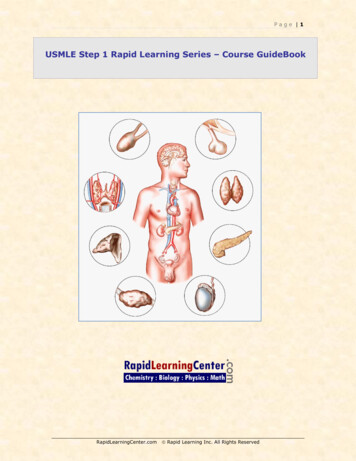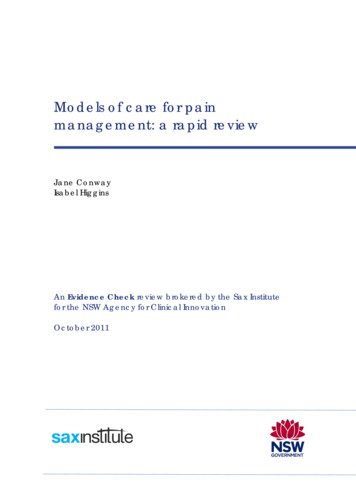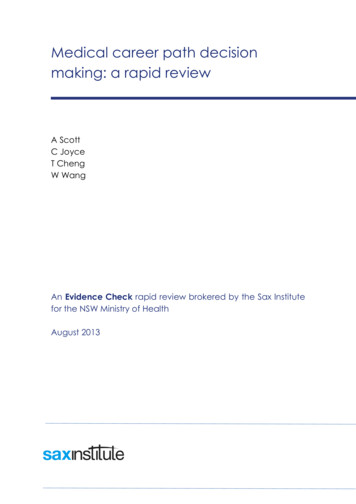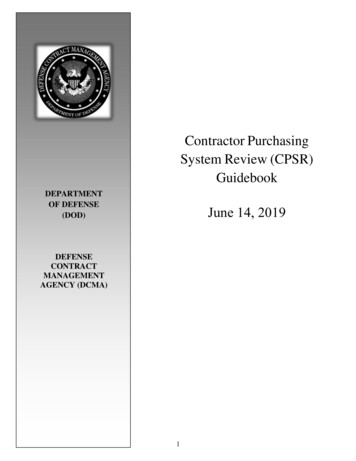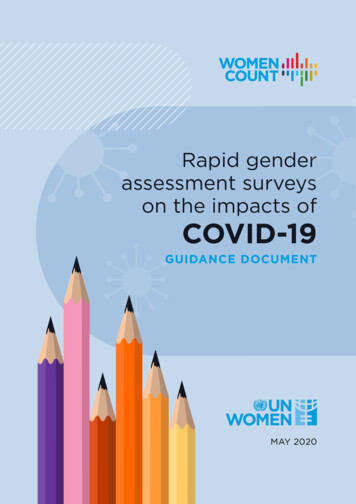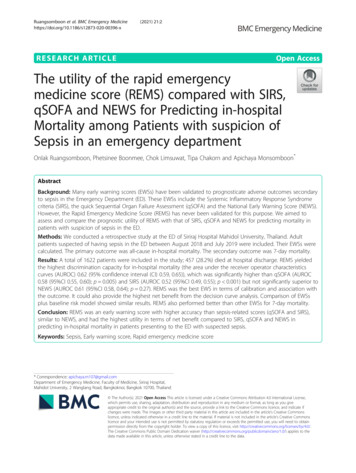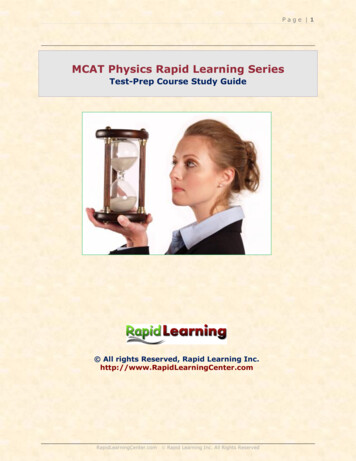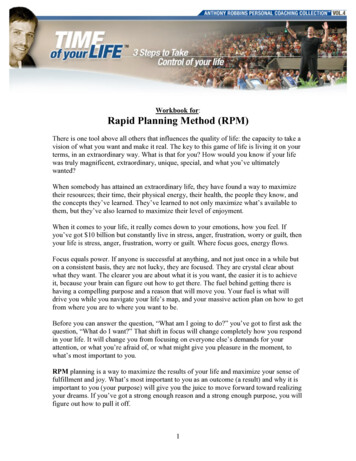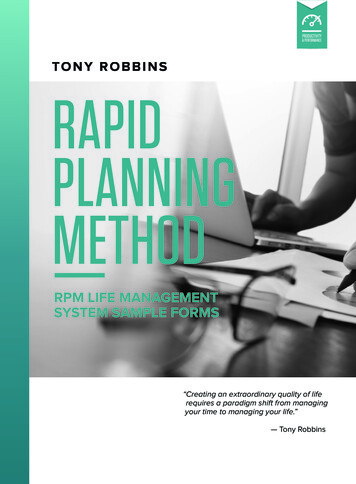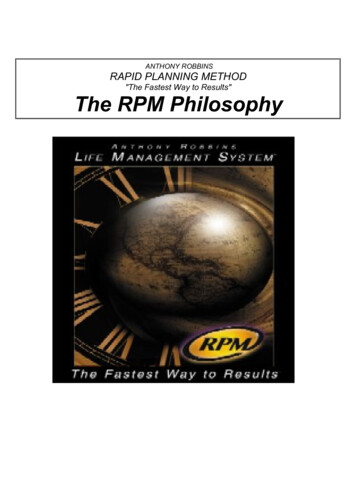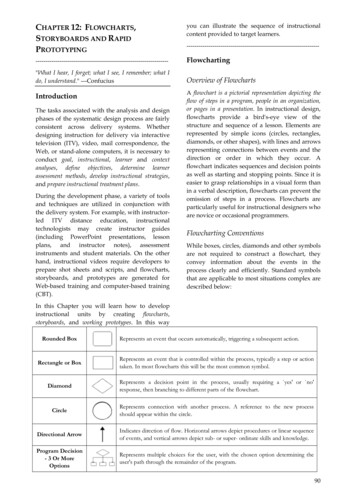
Transcription
Rapid Review GuidebookSteps for conducting a rapidreviewMaureen Dobbins, RN, PhD
Table of ContentsConducting Rapid Reviews2Purpose2Evidence-Informed Decision Making2Planning2Step 1: Define a Practice Question5Definition51.1 Type of practice question51.2 Develop a focused, clearly articulated, answerable practice question61.3 Confirm the practice question with your manager8Step 2: Search for Research Evidence9Definition92.1 Determine the database search strategy122.2 Conducting your search.132.3 Saving your search142.4 Citations retrieved – assessing for relevance14Overview of Search Process flowchart15Step 3: Critically Appraise the Information Sources16Definition163.1 Conduct critical appraisal16Step 4: Synthesize the Evidence – “Putting it all Together”17Definition174.2 Data synthesis194.3 Drawing implications20Step 5: Identifying Applicability and Transferability Issues for Further Consideration during theDecision Making Process21DefinitionWriting the Report2122Definition22Sections to include22Steps for Conducting a Rapid ReviewVersion 1.1 July 12, 2017Page 1
Conducting Rapid ReviewsPurposeThe purpose of this document is to provide guidance on the process of conducting rapid reviewsto use evidence to inform policy and program decision making. While a specific process isoutlined, it is understood that rapid reviews may vary in scope and methodology and thetimeline for preparing them may vary from a few days to several weeks or months. Ideally all ofthe outlined steps would be completed during a rapid review; however, there will be instanceswhere timelines will be such that some steps may need to be skipped, or some steps may notbe completed as thoroughly as they would be if more time were available. In instances wheretimelines are short, it is important to decide, with management, which steps must be completed,which ones may be skipped, and/or which ones may not be completed as thoroughly aspossible. Throughout this guide, suggestions are made where time can be saved, as needed,on particular steps. This guide follows the seven step process of evidence-informed decisionmaking promoted by the National Collaborating Centre for Methods and Tools. Rapid reviewsare a form of knowledge synthesis that follow the systematic review process, but components ofthe process are simplified or omitted to produce information in a timely manner (Khangura,2012).Evidence-Informed Decision MakingEvidence-informed decision making (EIDM) involves the translation of the best availableevidence from a systematically collected, appraised and analyzed body of knowledge forconsideration alongside other forms of knowledge in policy and program decisions. EIDM hasbeen defined as a process characterized by: 1) the articulation of public health practice-basedissues; 2) searching for and accessing relevant research evidence; 3) appraising themethodological quality of research evidence; 4) synthesizing the evidence; 5) adapting theevidence to the setting; 6) implementing the decision; and 7) evaluating the impact of thedecision on public health practice and potentially population health outcomes. This guide willdescribe the first five steps in the process.PlanningBefore working your way through these five steps it is important to plan. Planning to use theEIDM process includes the following steps. Steps 1 and 2 are further described in the nextpages.1. Preparing an overview of the public health topic.2. Initiating a document that will become a final report. Step 5 of this guide thoroughlydescribes each section of the final report and suggested appendices.3. Identifying key check-in points with your Manager/Associate or Medical Officer of Health.It is important to check in with your manager before you begin a rapid review andpossibly at the completion of each step along the way.Steps for Conducting a Rapid ReviewVersion 1.1 July 12, 2017Page 2
1. Prepare an Overview of the Public Health TopicThe purpose of the overview is to describe the public health policy or program issue, what iscurrently known about the issue, and conclude with the question that the rapid review aims toanswer. Gather all of this information (see section 1B), put it together in a written format and iftime allows, in a conceptual model as well. The written overview will form the first section of therapid review report. If a final report is produced, possible report sections are outlined in theWriting the Report section of this Guide.1A. Identify your Team and StakeholdersIdentify the primary lead, and other team members who will contribute to the rapid review.Identify those who have current knowledge of the issue who may be consulted, in particularpolicy and program decision makers in the health unit, epidemiologists, and library personnel.Consider who may be affected by the findings included in the rapid review. This may includeother staff in the program or external partners and stakeholders. There may also be people whoare more peripheral to the project who have an interest in the findings and wish to be informedof them. It will be important to remember these stakeholders for future knowledge exchangeinitiatives. The rapid review team may need to connect regularly with their manager during theinitial stages of the rapid review process to ensure the public health policy or issue is clearlydefined. The manager may need to connect with senior management during the process ofrefining the issue to ensure it is clear what is needed and wanted by senior management.1B. Define the Public Health TopicBriefly explain the public health policy or program issue and what is driving the need foraddressing the topic. The length of this section in the final report is one half page to one fullpage. Use the most current statistics, preferably Canadian, provincial and local data, to describeincidence and prevalence of the issue where appropriate. Include any information thatcompares the incidence and prevalence data with those of other relevant jurisdictions, ifappropriate. Contact the epidemiologist for the topic (if available) to identify or confirm relevantstatistics. A summary of current practices may also be included.Provide definitions for conditions if they would not be widely understood by senior decisionmakers. Describe any political situations or issues of relevance. Describe any communitysituations or issues of relevance, including important partnerships that could be affected by anypolicy or program change implemented as a result of the findings of the rapid review.Describe any practice issues that may be directly and/or indirectly affected by this rapid review,for the health unit and other partner or stakeholder organizations. Be sure, when quotingreferences, to use the primary source or reference and not a secondary reference (e.g. wherean agency has quoted a primary reference).Steps for Conducting a Rapid ReviewVersion 1.1 July 12, 2017Page 3
1C. Review Current Knowledge of the Public Health Topic, Issue, Disease or Situation(Review what you already have and then describe what the health unit already knows about thistopic)Work together with the people assigned to the project to come to a common understanding ofthe relationships and factors underlying the public health issue. This common understandingcan be acquired by reviewing a variety of materials such as: Systematic reviews on the issueOfficial statistics (such as the Chronic Disease Indicator Framework)Organizational reportsPast briefing notes on the issueRegional Risk Factor Surveillance SystemCanadian Community Health surveyProtocolsBest practice guidelinesManualsSituational analysis or environmental scansDeveloped models or frameworks for the issueConsultation with external partners, such as academicsGrey or unpublished literaturePractice reviewsKey informants or field experts2. Initiate the Document that will become the Final ReportCreate a program folder to electronically store your tools and documents. Create a documentwith the headings outlined in Writing the Report on page 22. Under the headings “PublicHealth Topic” and “Current Knowledge”, prepare a written description of the relevant informationthat you have identified in steps 1B and 1C. Explain the burden of illness associated with thepublic health issue, the threat to the population’s health, or other details that make the issueimportant. The team may also create a conceptual/logic model. Click on the following link to seean example of a logic model related to a youth suicide prevention ites/default/files/docs/PEtoolkit2013/Pg9 LogicModelTemplate Example EN.pdfThe remainder of this document will identify the activities involved in completingeach of the steps of a rapid reviewSteps for Conducting a Rapid ReviewVersion 1.1 July 12, 2017Page 4
Step 1: Define a Practice QuestionDefinitionA practice question is one that is relevant to policy and program decision making in the healthunit and is focused, clearly articulated and answerable. For example, in order for quantitativequestions to meet these criteria, the question may use the PICO framework, identifying thefollowing components: the Population of interest; the Intervention(s) and/or Exposure (riskfactor) being considered; the Comparator (what the intervention or risk factor is being comparedto); and Outcome(s). Questions should be framed to be neutral rather than focused on aparticular direction for the outcome. By framing the question in a neutral way you are in a betterposition to identify all of the research evidence relevant to the practice issue. Framing thequestion with a particular direction of the outcome (e.g. the intervention has a positive effect)may bias your search for evidence along the direction you have articulated. The following is anexample of a focused, clearly articulated, answerable, and neutral practice question:What is the impact of school-based physical activity interventions on time spent engagedin moderate to vigorous physical activity, among children aged 6-12 years of age, incomparison to children not exposed to school-based interventions?The following is an example of a practice issue that requires further refining in order to befocused, clearly articulated and answerable:What interventions are effective in reducing health inequalities?The following is an example of a focused, clearly articulated, answerable, but not neutralpractice question:Which school-based interventions are effective in increasing the amount of time childrenengage in moderate to vigorous physical activity?1.1 Type of practice questionA first step in defining a public health issue is in determining the type of question you have beenasked to address. The following are examples of some of the types of practice questions youmay be asked to answer with your rapid review: Intervention: What is the effect of an intervention or program on one or more outcomes?Harm/Causation: What is the relationship between a risk factor and an outcome? Forexample, the relationship between second hand smoke exposure and the risk for varioustypes of cancer.Diagnosis: What is the extent to which a tool accurately identifies the presence of adisease or health condition?Economics: Assess the relative cost of an intervention for the expected outcomeMeaning/Lived experience: What is the lived experience of a process or phenomenon?Steps for Conducting a Rapid ReviewVersion 1.1 July 12, 2017Page 5
1.2 Develop a focused, clearly articulated, answerable practice questionOnce the type of practice question has been determined, it is time to define the question. Fromthe above list, questions related to Intervention, Harm, Diagnosis and Economics are generallyanswered using quantitative research, while questions related to Meaning/Lived experience areanswered by qualitative research. When a practice question is quantitative in nature, thefollowing components should be identified as specifically as possible: Population,Intervention/Exposure, Comparison, and Outcome(s). The acronym PICO is used whenaddressing the effectiveness of an intervention or PECO if assessing the relationship between arisk factor to which a population is exposed and a (health) outcome. However, if a practicequestion is qualitative then the following components should be articulated: Population andSetting, or PS.Depending on the question needing to be addressed, other frameworks may be applicable.When a request for a rapid review is received, the primary lead should confirm the scope of thepractice issue with their manager. If the scope is not clearly defined at the outset, the managerwill seek additional clarity from senior management. It may be helpful to conduct a quickliterature search to help inform the scope. Consider contacting a librarian, if available at yourorganization, to help scope the research question. It is important that team membersunderstand the purpose of the review (e.g., what decision makers need and why they need thisinformation). Specific questions that can be asked to ensure that the practice issue is clearlydefined and understood by those developing the rapid review include:1.2.3.4.Which populations are of interest?What interventions/programs or risk factors are to be included?Are there any interventions/programs or risk factors that should be excluded?What outcomes should be addressed and/or excluded?For qualitative questions, for example “what are the lived experiences of caregivers of youthwith mental illness?”, the components requiring definition include: Population and Situation.However, even for some quantitative questions, it may be useful to gather qualitative researchrelated to an intervention or risk factor that has been evaluated. For example, while the rapidreview may focus primarily on the impact of an intervention/program on specific outcomes,qualitative research may provide further insight into why the intervention was effective or not, forwhom, and in which setti
Conducting Rapid Reviews 2 Purpose 2 Evidence-Informed Decision Making 2 Planning 2 Step 1: Define a Practice Question 5 Definition 5 1.1 Type of practice question 5 1.2 Develop a focused, clearly articulated, answerable practice question 6 1.3 Confirm the practice question with your manager 8 Step 2: Search for Research Evidence 9 Definition 9File Size: 630KBPage Count: 25
